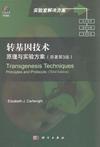转基因技术
出版时间:2012-4 出版社:科学出版社 作者:卡特莱特 页数:335
内容概要
在后基因组时代,学界所面临的主要挑战之一是如何破解大量的编码蛋白质的基因功能。在《转基因技术(原理与实验方案原著第3版导读版)(精)》(作者卡特莱特)中,该领域的专家在第2版的基础上进行了更新和补充,以求能够详尽地反映当前基因修饰技术的最新进展。《转基因技术(原理与实验方案原著第3版导读版)(精)》不仅包括基因修饰小鼠制作过程,同时也介绍了其他模式生物的转基因技术,以及在显微注射、位点特异性重组系统、冷冻保存等方面的探索和尝试。本书秉承Springer《分子生物学方法》系列丛书的一贯风格,阐述明晰、便于使用,每章包括对相关问题的介绍,所需材料和试剂的清单,实验操作的具体步骤,以及常见问题的解决方法和缺陷规避。
书籍目录
前言
撰稿人
第一部分 多种模式动物的转基因技术
1 转基因果蝇
2 转基因线虫
3 利用Tol2转座子系统制作转基因斑马鱼
4 转基因爪蟾
5 利用DNA前核注射制作转基因大鼠
第二部分 小鼠的转基因技术
6 细胞类型特异的转基因小鼠
7 设计转基因载体和DNA转入基因组一成功的关键
8 过表达转基因一前核显微注射
9 基因打靶载体
10 基因捕获:基因敲除的快速通道
11 小鼠胚胎干细胞的培养
12 打靶胚胎干细胞
13 通过显微注射获得嵌合体小鼠
14 通过桑葚胚细胞聚集获得嵌合体小鼠
15 获得突变体小鼠相关的手术操作
16 用于小鼠基因组修饰相关的位点特异性重组酶
17 Cre转基因小鼠
18 大规模小鼠基因突变
19 小鼠的繁殖和饲养
20 维持和保存实验室变异小鼠的生物学方法
Ⅰ:保存突变小鼠株
21 维持和保存实验室变异小鼠的生物学方法
Ⅱ:复苏突变小鼠株
索引
章节摘录
Summary Transgenesis in Drosophila melanogaster relies upon direct microinjection of embryos and subsequentcrossing of surviving adults.The necessity of crossing single flies to screen for transgenic events limits therange of useful transgenesis techniques to thosc that have a very high frequency of integration,So thatabout 1 in 10 to 1 in 100 surviving adult flies carry a transgene.Until recently,only random P—elementtransgenesis fulfilled these criteria.However,recent advances have brought homologous recombinationand site—directed integration up to and beyond this level of efficiency.For all transgenesis techniquesin Drosophila melanogaster, microinjection of embryos is the central procedure.This chapter gives adetailed protocol for microinjection,and aims to enable the reader to use it for both site—directed inte—gration and for P—element transgenesis. Key words:Drosophila melanogaster,Embryo,Microinjection,Transgenic,Recombination,Inte—gration,Homologous recombination,phiC31/integrase,Site—directed integration,p—element 1.1ntroduction Transgenesis in Drosophila melanogaster has undergone somethingof a revolution in the last few years.The classical technique ofrandom P—element—mediated transgenesis has recently been sup—plemented by two novel technologiCS:homologous recombi—nation and ΦC31 integration(for reviews,see(1)and(2).InP—element transgenesis(3),a modified transposon vector is usedin combination witll transient expression of the P transposaseenzyme to generate several fly lines、with different insertion sitesin the genome.These insertions are subsequently mapped andcharacterised.P—element insertions have been invaluable formutagenesis screens,but until recently,this was also the only metllod available for introducing a transgene of choice into theDrosophila genome.The random nature of P—element insertaonshas sevcral drawbacks for transgene analysis.Mapping of inser—tion sites iS time consuming、and transgene expression levels aresubject to genomic position effects,making it difficult to drawcomparisons between different constructs. A recently developed alternative to random insertion ishomologous recombination(4,5).This involves inserting adonor construct at random into the genome by P—element trans—genesis,and in subsequent generanons,mobilising the donorconstruct to the correct locus by homologous recombination.This technique had long been lacking to Drosophilists,but hasnot replaced P—element transgenesxs as the method of choice torroutine transgene analysis.because both the cloning of donorconstructs and the generation of homologous recombinants aremore time consuming than for P—element transgenesis. Reccently,ΦC31 integration has been developed(6). Thistechnique allows rapid and efficient generation of site—specificintegrants,and relies upon‘docking site’fly lines,which carrya single recognition site(attP)for the phage ΦC31 integraseenzyme.previously introduced into the genome by P—elementtransgenesis.A donor plasmid carrying a second recognition site(attB)and a source of integrase enzyme is used to generate thcs inwhich the donor plasmid docks to the genomlc site.Integrationevents are highly specific,as the attP site is 39 bp long and doesnot occur at random in the Drosophila genome.Many mappedand characterised docking site lines arc now available(see Note 1),and ΦC31 integration is rapidly becoming widely used for manytransgcnic atmlications. ……
编辑推荐
《转基因技术:原理与实验方案(实验室解决方案)(原著第3版)》特点: 本书为Springer经典实验室指南系列《分子生物学方法》(Methodsin Molecular Biology)的分卷。 第3版对制备转基因动物的实验室可提供全面指导,对进行与转基因相关科学研究的实验室亦可提供丰富、宝贵的知识和信息。
图书封面
评论、评分、阅读与下载
